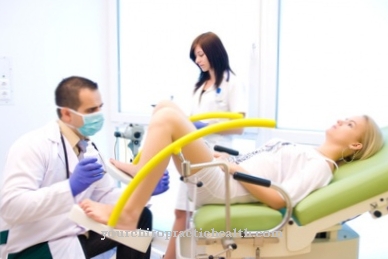The Direct current therapy is a form of electrotherapy that is particularly used for circulatory disorders, neuralgia and cancer treatment. In this therapy, depending on how it is carried out, excitation of muscle and nerve cells is dampened or increased. However, if the current is too strong on the electrodes, necrosis can occur as side effects.
What is DC Therapy?
Direct current therapy is electrotherapy performed with direct current. In addition to direct current therapy, there are also various forms of alternating current therapy. Low, medium or high frequency alternating currents are used.
The prerequisite for direct current therapy is the presence of two electrodes between which a current flows. The electrodes are each a cathode and an anode. The cathode is negatively charged. From there, electrons migrate to the positively charged anode via ion and electron transfer. A special chemical milieu develops at each electrode, which changes the membrane potential on the nerve cells. This leads to hyperpolarization at the anode and depolarization of the membrane potential at the cathode.
Function, effect & goals
Direct current therapy is used on the one hand for analgesia (pain relief) in various diseases such as osteoarthritis, arthralgia, back pain, fibromyalgia or neuralgia, and on the other hand for the treatment of circulatory disorders.
The circulatory disorders treated in this way can be both functional and organic. These include arterial occlusive disease, hematomas or ditorsions. The mechanism of action of direct current therapy is based on the different polarization at the membrane potentials of the cells. As already mentioned, hyperpolarization occurs at the anode and depolarization occurs at the cathode. Every cell has a resting potential. In the event of a depolarization, this potential is reduced by the influx of sodium ions into the cell interior. In contrast, hyperpolarization is characterized by an increase in the resting potential. While the depolarization increases the excitability of the nerve and muscle cells, the excitability is dampened by the hyperpolarization.
The attenuation of the excitability at the anode causes the analgesic effect of direct current therapy. Furthermore, there is also hyperemia (strengthening of the blood flow), which is caused by the irritation of the vasomotor nerves, the release of vasoactive substances and the change in the pH value. This affects the skin and skeletal muscles. This process takes place on the cathode. The direct current can also transport substances.
Overall, the direct current strengthens the metabolic and nutritional status, growth and regeneration of the cells. The switching of the electrodes has a great influence on the effect. That is why it must be clear before the therapy which effect is to be achieved. There are various methods of direct current therapy for this purpose. For example, four-cell or two-cell baths are used in patients with polyneuropathy or cardiac diseases. If there are functional or vegetative disorders, the Stanger bath is used. This method is used to treat anxiety, pain and, in particular, pain associated with bone cancer metastases. The Stangerbad is a full bath in which the patient lies in the bathtub.
The electrodes are located outside and ensure the galvanic direct current into the bathtub. Depending on the polarity, the Stangerbad has a calming or stimulating effect. However, excitement does not usually pass to the muscles. Another application method of direct current therapy is iontophoresis. With this method, continuous or pulsed direct current is passed through defined areas of the skin. The pulsed direct current is particularly suitable for sensitive people because there are hardly any side effects. However, continuous direct current is more effective. The mode of action of iontophoresis is not yet fully understood.
However, good results are achieved with hyperhidrosis (increased perspiration), with foot and hand eczema caused by hydrosis, or with a tendency to gram-negative foot infections. Overall, direct current therapy has the advantage that it can be carried out very well on an outpatient basis. In cancer, the formation of metastases is prevented. In addition to combating pain and promoting blood circulation, this procedure also improves wound healing.
You can find your medication here
➔ Medicines for painRisks, side effects & dangers
However, there are also disadvantages to direct current therapy. It must not be used with cardiac pacemakers, sensory disorders, thromboses, skin lesions, open wounds, metal implants, inflammations and febrile processes.
This therapy should also be avoided in the case of pulmonary hypertension or decompensated heart failure. This is especially true for the use of a Stanger bath. The influence of electricity can lead to dangerous complications with these pre-existing conditions. Otherwise, treatment with direct current usually has no side effects if it is carried out correctly. Only with treatments in the chest area, face or neck can there be mild and harmless side effects. Symptoms such as a metallic taste or flickering eyes can then occur during head treatments.
Sometimes colored flashes appear instead of flickering eyes. The ophthalmologist should only be consulted if the colored flashes persist in order to rule out a possible detachment of the retina. However, improper use of direct current therapy can cause necrosis. So-called coagulation necrosis occurs at the anode and colliquation necrosis at the anode if the current is too high. In coagulation necrosis, cytoplasmic proteins are denatured. The tissue in question dies.
The colliquation necrosis occurring at the cathode is characterized by the liquefaction of the tissue. Tissues with a high fat and low collagen content such as the brain or the pancreas are particularly at risk. The different forms of necrosis are caused by the different development of the pH value on the corresponding electrodes.


























